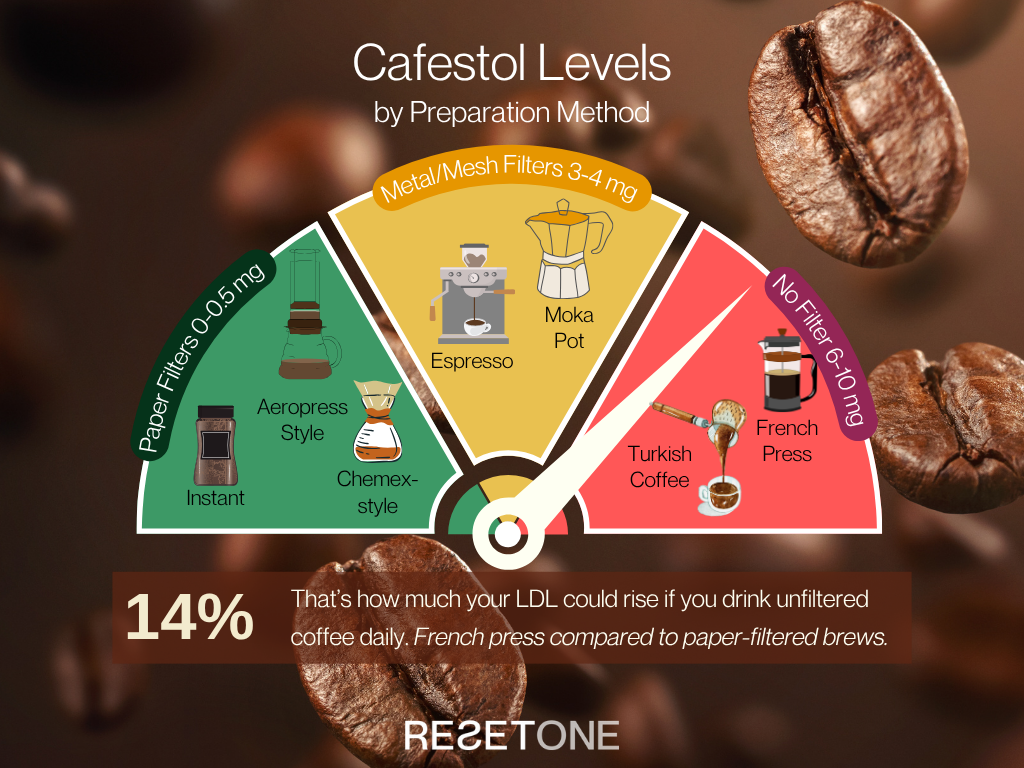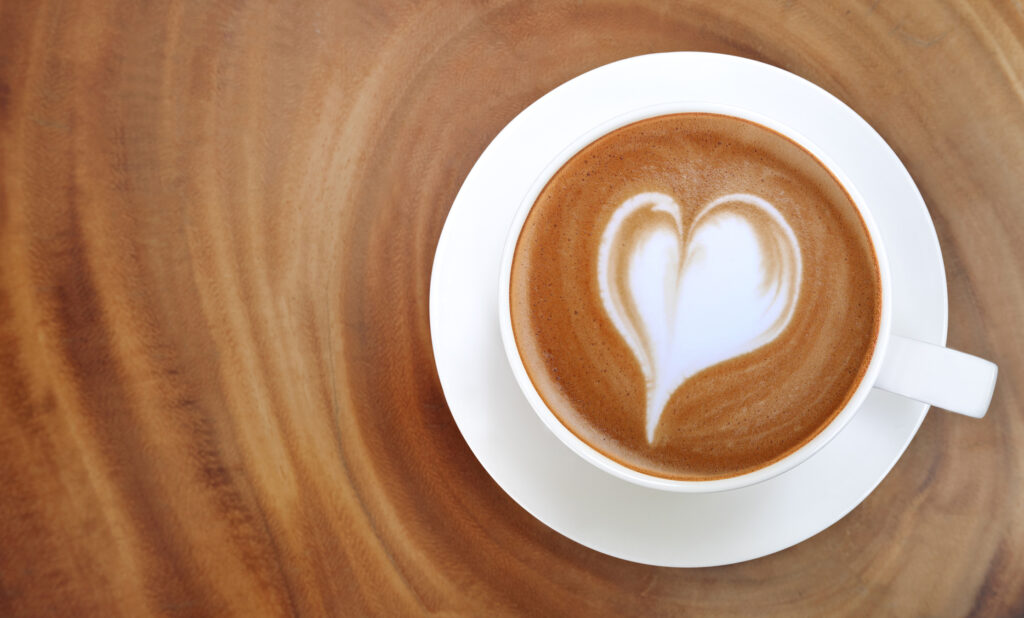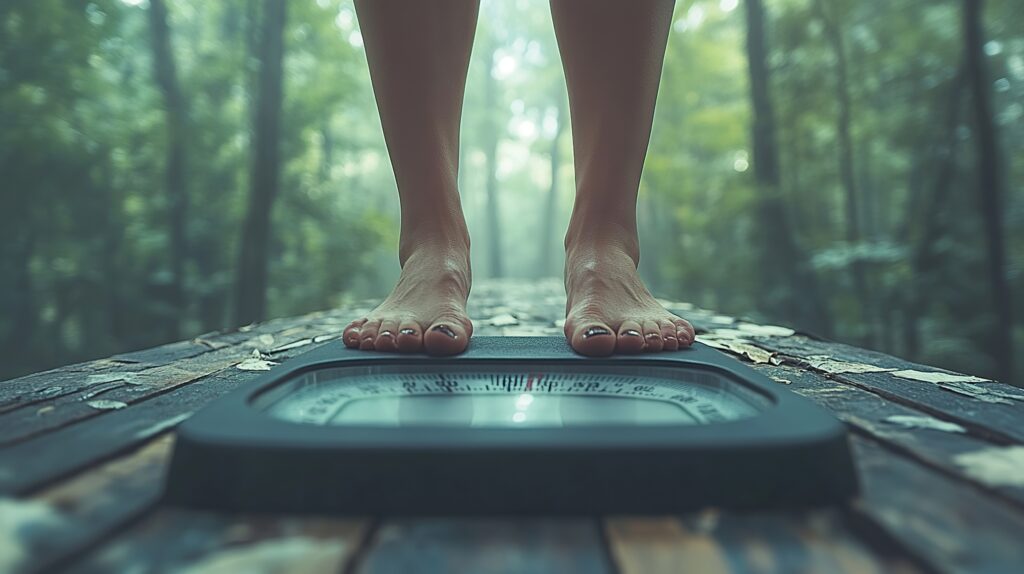- What is Cafestol?
- How Your Brewing Method Changes Cafestol Levels
- Should You Rethink Your Coffee Routine?
- About those Paper Filters
- How to Clear Cafestol from Your System After Cutting Back on Unfiltered Coffee
- Small, Intentional Changes Make a Difference
If you’re like most, coffee is a non-negotiable part of your morning. In fact, the latest data from the National Coffee Association shows 66% of Americans drink it daily, and the average coffee drinker downs about three cups a day. But have you ever thought about how your brewing method might be affecting your cholesterol levels? Probably not, but you should. It all comes down to a compound called cafestol: a sneaky little molecule that can nudge your LDL (“bad”) cholesterol higher depending on how you brew.
What is Cafestol?
Cafestol is a naturally occurring compound found in the oily part of coffee beans, and it plays a surprisingly powerful role in cholesterol metabolism. Unlike caffeine, which gives you that familiar jolt of alertness, cafestol works behind the scenes, specifically in the liver. Studies show that it suppresses bile acid synthesis by inhibiting receptors like FXR (farnesoid X receptor), which help regulate how the liver processes and excretes cholesterol.
The result? LDL (“bad”) cholesterol levels can rise significantly when cafestol is consumed in higher amounts over time. In fact, clinical studies have shown that drinking unfiltered coffee daily, such as French press or Turkish coffee, can raise LDL by as much as 8–14%, depending on dose and duration.
The surprising key variable isn’t the coffee itself, it’s actually how it’s brewed.
Brewing methods that don’t use paper filters allow more cafestol to seep into your cup, which is why filtering matters for your heart.
How Your Brewing Method Changes Cafestol Levels
You have more control over your coffee than you think. The way you brew your coffee determines how much cafestol ends up in your cup:
High Cafestol | 6-10 mg | French Press & Turkish-style
These methods don’t remove the natural oils in coffee, so cafestol stays in your cup.
Moderate Cafestol | 3-4 mg | Espresso, Nespresso, and Metal Mesh Makers
Because espresso is brewed quickly under high pressure, it contains cafestol, but at moderate levels. Metal mesh filters also allow moderate levels of cafestol to flow through.
Low Cafestol | 0-0.5 mg | Paper-Filtered Methods & Instant
Drip coffee makers, pour-over brewers, and Aeropress-style makers used with a paper filter trap cafestol effectively. These are the best options if you’re mindful of cholesterol.

Are There Other Foods or Drinks That Contain Cafestol?
Nope! Coffee is the only known source of cafestol. If you’re concerned about its effects, switching up your brewing method is the only way to reduce your intake. There’s no need to overhaul your entire diet for this one.
A Quick Note on Cafestol’s Complexity:
While cafestol is best known for raising LDL cholesterol, like so many other nutritional villains, it may have a few redeeming qualities, too. Early studies suggest potential benefits, including improved glucose metabolism and antioxidant activity, though most of that research is still in its early stages. Until we know more, it’s smart to limit cafestol if you’re prioritizing heart health.
Should You Rethink Your Coffee Routine?
Before ordering your next cup, ask your local coffee shop how they prepare their beans. Many shops use different brewing methods, and knowing whether they use paper filters or metal mesh can help you make a more informed choice. If you’re unsure, opt for a classic drip coffee or pour-over with a paper filter to minimize cafestol intake.
If you’re brewing at home, check what type of filter your coffee maker uses and adjust accordingly. If you have a machine with a metal filter, consider adding in a paper filter or using a pour-over method to reduce cafestol exposure.
If you’re someone who drinks multiple cups of French press or unfiltered coffee daily, it might be worth swapping in some paper-filtered to keep your cholesterol in check. But if you’re an espresso lover, don’t stress…moderation is key.
About those Paper Filters
Not all paper filters are created equally. For maximum cafestol removal, choose bleached or bonded paper filters, like those used in Chemex or high-quality drip brewers. These thicker filters are especially effective at trapping oils.
Avoid using thin or reusable cloth filters if you’re watching your cholesterol; they let more cafestol through.
How to Clear Cafestol from Your System After Cutting Back on Unfiltered Coffee
If you’ve decided to cut back on unfiltered coffee to lower your cafestol intake, but if you’ve been drinking it that way for a while, your body may need a little help clearing out lingering cafestol. Here’s how to speed up the process and support your liver along the way:
1. Give Your Liver Some Love
Cafestol is processed in the liver, so keeping this powerhouse organ in top shape is key. Load up on cruciferous veggies (broccoli, Brussels sprouts, kale) and sulfur-rich foods (garlic, onions, eggs) to support detox pathways. Hydration is also crucial—aim for plenty of water to keep things flowing. If you want an extra boost, supplements like milk thistle, NAC, or glutathione can help optimize liver function.
2. Get Bile Moving
Your body clears cafestol through bile, so encouraging healthy bile flow is a game-changer. Add bitter foods like dandelion greens, artichokes, and lemon to your diet, and make sure you’re getting enough fiber (flaxseeds, psyllium, chia) to help trap bile and move it out of your system. Regular movement also supports bile circulation, so don’t skip your workouts!
3. Prevent Cafestol from Circling Back
Cafestol can be reabsorbed in the gut and keep circulating through your system. To stop this cycle, fiber is your best friend; it binds to cafestol-containing bile and flushes it out. Some people use activated charcoal occasionally to help trap lingering cafestol, but fiber is the safer, more sustainable option. A healthy gut microbiome also plays a role, so adding probiotics can support the process.
4. Optimize Fat Digestion
Because cafestol is fat-soluble, the way your body processes fats matters. Focus on healthy fats like omega-3s and olive oil, and avoid overloading on saturated fats, which can slow bile clearance. If you have gallbladder issues or sluggish digestion, digestive enzymes may help your body break down fats more efficiently.
5. Be Patient, But Stay Consistent
Cafestol doesn’t clear overnight, especially since it can recirculate through bile before your body finally eliminates it. The good news? With the right diet and lifestyle adjustments, you can help speed things up. Stay consistent with liver-supporting foods, fiber, and movement, and in a few weeks, your body will naturally recalibrate.
Small, Intentional Changes Make a Difference
Coffee is a powerhouse for longevity, if you know how to brew it properly. At ResetOne, we believe that small adjustments can add up to big changes in your health. The way you brew your coffee is just one tiny piece, and we’re here to help you make informed choices that align with your goals.
If you learned something today, share this with a coffee-loving friend!
Long live longevity.™




